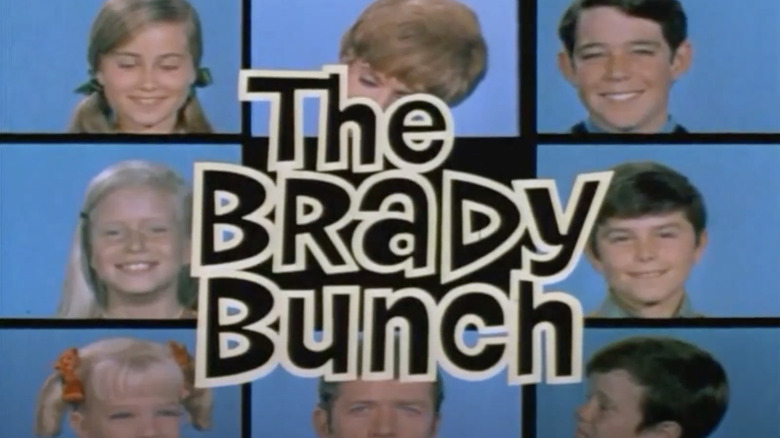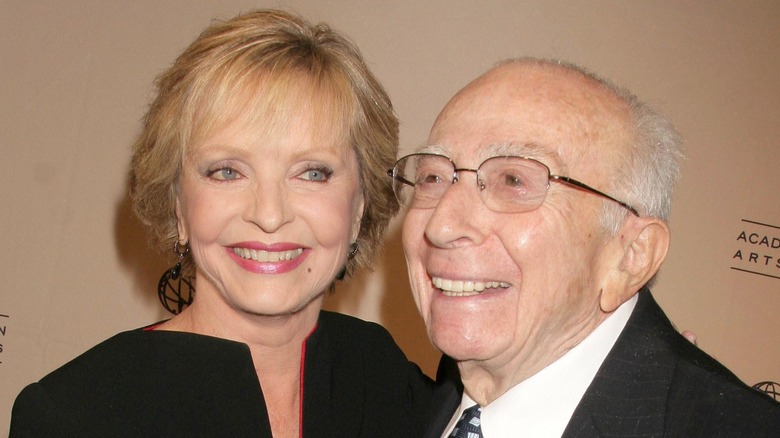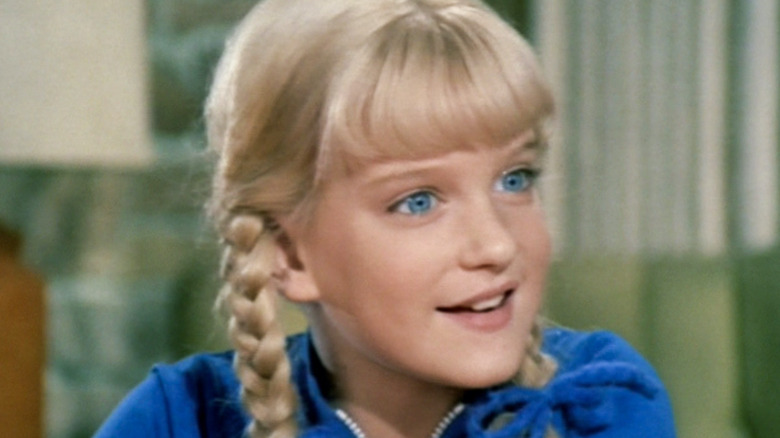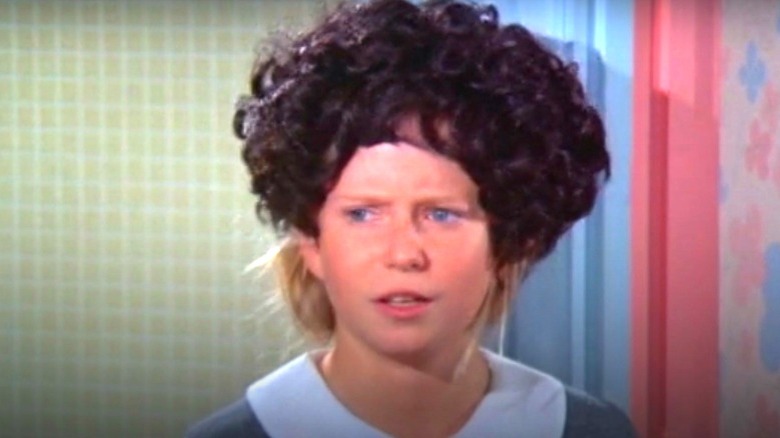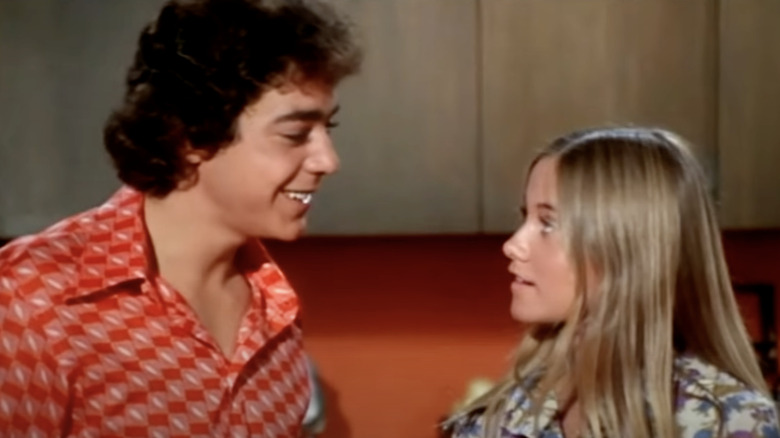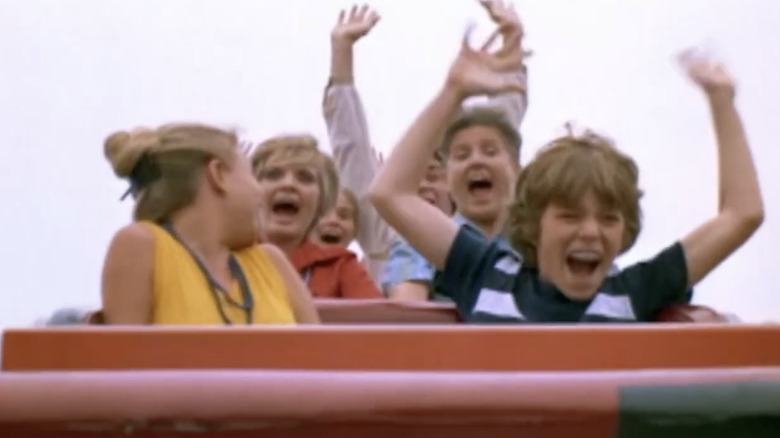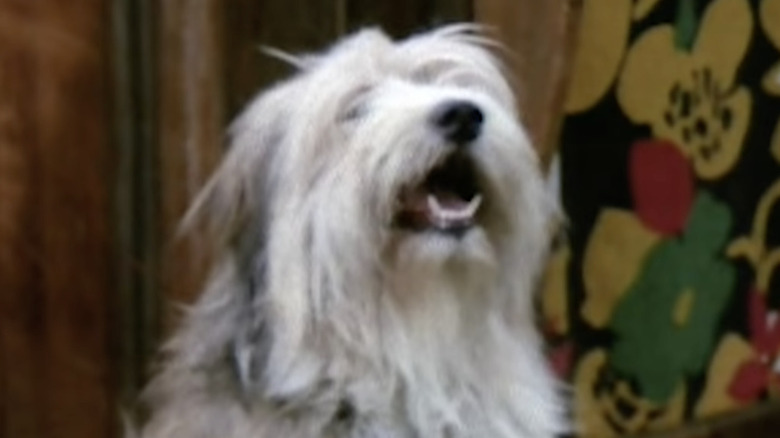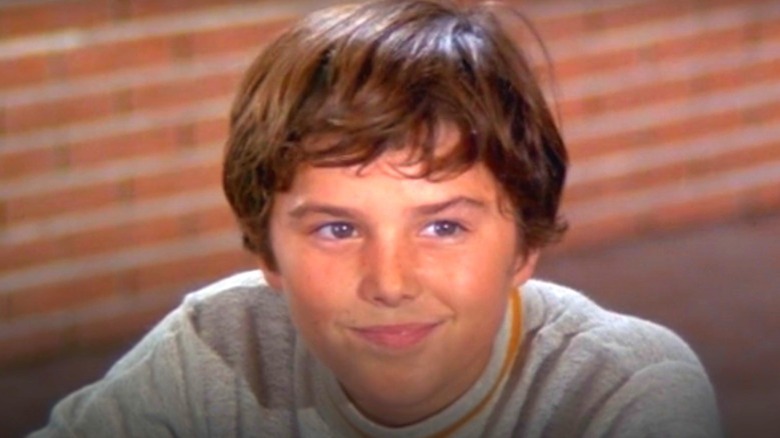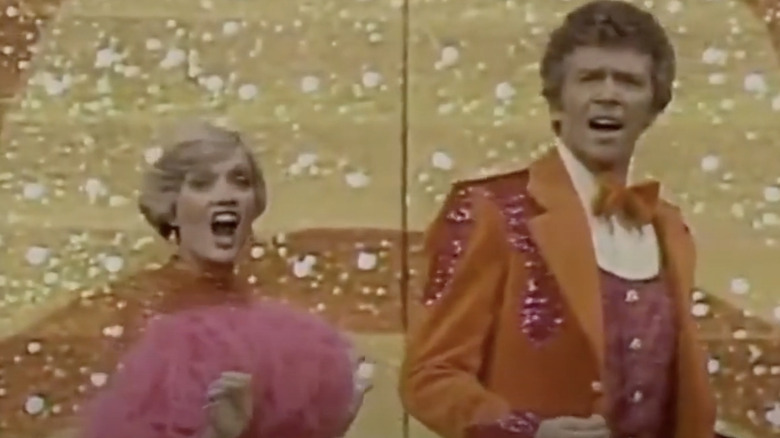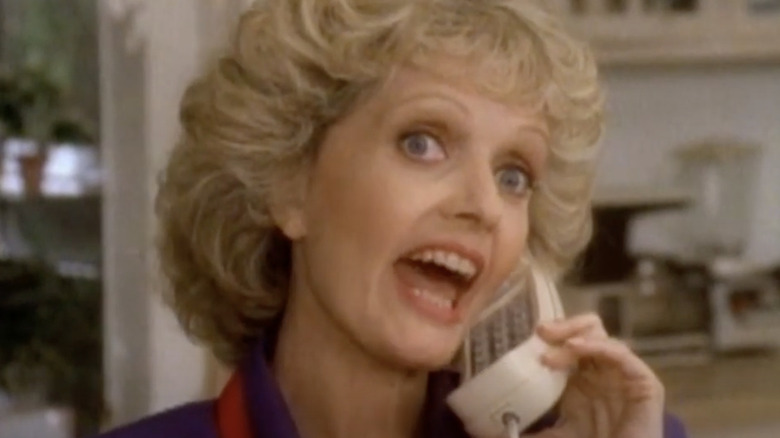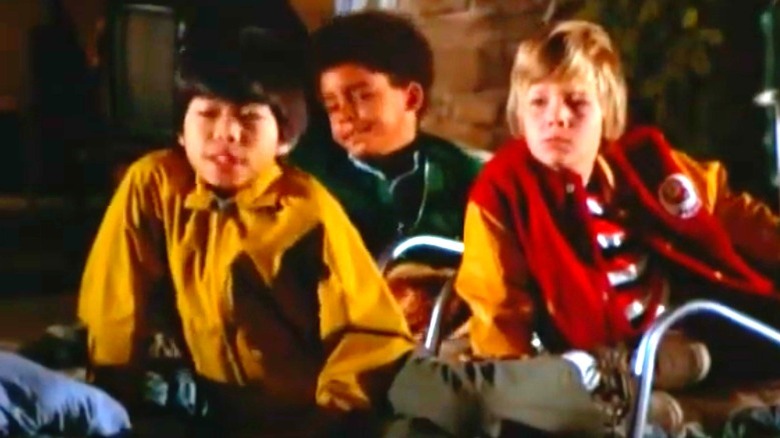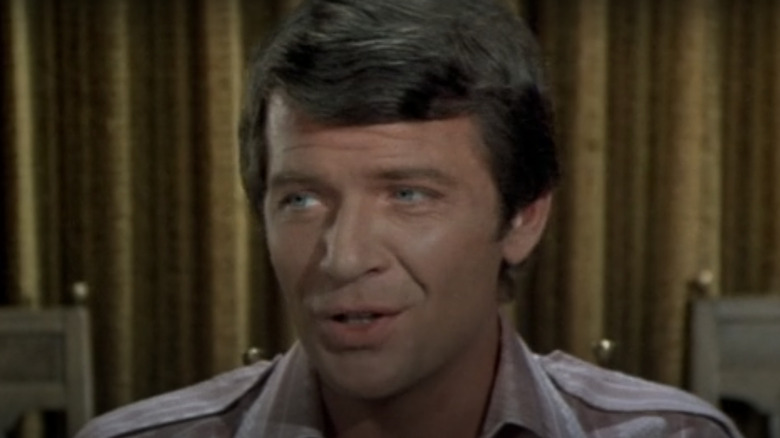The Untold Truth Of The Brady Bunch
A tic-tac-toe board of fresh and happy faces smiling at each other while a small army of singers explain how and why this group would somehow form a family — that's the way each episode of "The Brady Bunch" began. Originally airing on ABC Friday nights from 1969 to 1974, "The Brady Bunch" would become a signature show of American television of the era: a groovy, outta sight, but squeaky-clean and delightfully cheesy sitcom about the then-new phenomenon of blended families.
Should the show's infinitely ear-worming theme song from one of its endlessly running reruns fail to register, it's the story of sweet and fun Carol Brady (Florence Henderson), a single mom of three girls, Marcia, Jan, and Cindy — all who have hair of gold, like their mother — who combines her life and family with her second husband, good guy architect Mike Brady, a widower and father to three boys, Greg, Peter, and Bobby.
"The Brady Bunch" is a touchstone for multiple generations and part of the shared collective cultural knowledge of America. It looms large not just in the history of TV, but movies, too, with its ironic and meta big-screen versions in the '90s. Hope for a sunshine day, avoid flying footballs, and keep on, keep on, because here's the story ... of "The Brady Bunch."
A factoid inspired the creator
In the 1950s and 1960s, family sitcoms were almost always about the traditional nuclear family unit — a man married to a woman raising their shared biological children. In the real world, the definition and makeup of the American family was evolving, and it was a brief, statistical mention of that in the Los Angeles Times that inspired Sherwood Schwartz to create the show that would become "The Brady Bunch." "It said that year, 1965, 31% of all marriages involved people who had a child or children from a previous marriage," Schwartz told Brady World in 1998. "It indicated a remarkable sociological change in our country. 31% is approximately one-third of all marriages. That's a huge statistic."
Sure, a show reflecting a progressive reality was an angle, but Schwartz, a veteran radio and TV sitcom writer, realized such a familial dynamic offered ample plot potential. "Not only could there be sibling rivalries, but there could be cross sibling rivals. And the problems each parent would have trying to convince the 'new' children that they loved them just as much as their own."
In hammering out an outline for this theoretical series, Schwartz also wrote out a theme song that would explain the somewhat complicated setup of the show. Not only did that turn into the universally known theme song from "The Brady Bunch," but it ensured that Schwartz wouldn't have to script much exposition.
All three networks rejected The Brady Bunch
Sherwood Schwartz went about selling "The Brady Bunch" in 1965, approaching all three American TV networks, according to Brady World. First up was NBC, whose programming executives saw promise in the idea, but hated the ending of the pilot, in which the newlywed Mike and Carol Brady feel weird and lonely on their honeymoon, so they go back and retrieve their six children. NBC thought it was far-fetched that a just-wed couple would make their honeymoon a family vacation, and Schwartz countered that the gesture would endear them to audiences "for showing that kind of concern." Since he wouldn't change the twist, NBC passed on "The Brady Bunch." Schwartz also refused to make changes requested by CBS personnel, who wanted him to lead up to the marriage of Mike and Carol in the sixth or seventh episode, rather than putting it in the pilot.
Schwartz's third and final stop: ABC. At the time, the network was pioneering a movie-of-the-week concept, and wanted Schwartz to rewrite his pilot into a 90-minute telefilm. "I told them I couldn't make my half-hour script last for an hour and a half without making it duller," he recalled. ABC passed too, but they approached Schwartz more than two years later with an offer. The success of the 1968 movie "Yours, Mine and Ours" created a vogue for shows about blended families, and ABC bought "The Brady Bunch," which, oddly enough, was originally titled "Yours and Mine."
A different bunch could have portrayed The Brady Bunch
Finding the right actors was crucial for creator Sherwood Schwartz, and according to Brady World, producers auditioned more than 1,200 young actors for the six principal child roles, winnowed down to 464 that Schwartz interviewed himself. In her 2014 memoir, "The Partridge Family" star Shirley Jones wrote that she turned down an offer to play Carol Brady, because she "didn't want to be the mother taking the roast out of the oven and not doing much else." Schwartz nearly gave the part to Joyce Bulifant (best known as Marie on "The Mary Tyler Moore Show"), but decided on Florence Henderson after seeing her excellent screen test. Once Henderson was cast, Schwartz also rejected his original choice for Alice, "The Red Skelton Show" cast member Monty Margetts, deciding a more dynamic comic performer would be better, and hiring Ann B. Davis.
Robert Reed, at the time best known for the legal drama "The Defenders," was tested by production company Paramount for three shows, and they hired him for "The Brady Bunch" after passing on a couple of other options. Schwartz wanted Gene Hackman — who would go on to win two Academy Awards — but Paramount didn't like his lack of TV experience. And according to "The Way We All Became the Brady Bunch" (via EW), Jeffrey Hunter, who played the original captain in the original pilot of "Star Trek" before being replaced by William Shatner, lobbied hard and unsuccessfully to play Mike Brady.
Barry Williams dated members of his TV family
While all nine main cast members of "The Brady Bunch" will probably always be most closely associated, and even conflated with, the roles they played on the 1969 to 1974 series, it's important to remember that Barry Williams is not really Greg Brady, nor was Maureen McCormick his stepsister nor the late Florence Henderson actually his stepmother. Otherwise, Williams' off-screen, romantic dalliances could be considered somewhat incestuous.
In her book "Here's the Story" (via CBS News) McCormick wrote that she and Williams "couldn't hold back" their attraction any longer and while shooting some episodes in Hawaii in 1972, shared their first kiss. Williams wrote in "Growing Up Brady" that after the Hawaii jaunt, he and McCormick would sneak away to his dressing room and make out during shooting breaks. According to producer Sherwood Schwartz, the sexual tension between the two actors was so palpable while shooting a scene for the 1973 episode "Room at the Top" that he had to physically distance the duo.
In "Growing Up Brady," Williams revealed that early in the show's run, he harbored a crush on his TV mom, and although at the time Henderson was a married woman, she agreed to go out on a date with her young co-star. He took her out for an innocent night at the Coconut Grove nightclub in Los Angeles.
A roller coaster could've killed The Brady Bunch
In the 1973 episode "The Cincinnati Kids," the Bradys visit Kings Island, a newly opened Ohio theme park. According to Kings Island Central, the episode was essentially an advertisement — producer Paramount was a primary shareholder in Taft Broadcasting, Kings Island's parent company. One scene called for the cast to enjoy the park's signature gigantic wooden roller coaster. According to Barry Williams' "Growing Up Brady," the crew planned to mount a camera on the front of the ride, then point it into the cars to film the real reactions of the "Brady Bunch" actors during the experience. Technicians put the camera on a platform, affixed it to the ride, and were ready to go, until cast member Robert Reed refused to continue.
"I'm thinking to myself, 'When that thing gets going at 60 miles an hour, I'm not sure that whole rig's gonna clear all the overhead stuff on the tracks,'" he recalled. After observing the tracks, he saw "several places where it would never get through." He pointed this out and made his reservations known, and placating him, producer Lloyd Schwartz ordered a test run of the coaster with the mounted rig in place, but without the actors on board. The coaster car made a circuit of the ride and returned without the camera, which had broken off along the way, proving Reed correct and probably saving the cast from serious injuries or worse.
Whatever happened to the Bradys' pets?
The pilot episode of "The Brady Bunch" introduced 11 characters — the eight Bradys, housekeeper Alice, and two pets: the girls' cat, Fluffy, and the boys' dog, Tiger. Fluffy never appeared or was mentioned on the show ever again, according to The Encyclopedia of TV Pets, while Tiger appeared in seven episodes from 1969 to 1971 before disappearing from the Bradys' world.
In that limited time, multiple dogs played Tiger. A pup named Chip got the role in the pilot, but producers contracted with a different animal casting supplier, necessitating a new dog to play Tiger, one actually named Tiger. One day, Tiger wasn't responding to commands and wouldn't do what was asked of him by the trainer. "All Tiger had to do was lie on the floor in the boys' room and look up soulfully at them," "Brady Bunch" creator Sherwood Schwartz said. "He wouldn't stay on the floor," so the crew nailed his collar to the floor to keep him in place.
When questioned after the scene was finally captured, the trainer admitted that Tiger wasn't acting well because it was a completely different dog than who'd been appearing in "The Brady Bunch" up to that point. The previous Tiger had tragically been struck and killed by a truck the night before.
The Brady Bunch was never a mega hit
"The Brady Bunch" is one of the most enduring television shows of all time, with reruns popping up regularly in daytime and weekend time slots on local TV stations and cable networks for more than four decades. Neither its omnipresence in the years after it was a show on ABC's primetime schedule, nor its status as a moving time capsule of early 1970s pop culture, should be considered proof of its contemporaneous popularity, however, because in its original run, "The Brady Bunch" wasn't much of a hit.
The sitcom never placed in the list of the top 30 most-watched TV shows in any of its five years. In the 1969-1970 TV season, it ranked 56th, topped out at 31st place in the 1971-72 season, fell to 45th in the 1972-73 frame, and then finally to 54th in 1973-74, which wasn't good enough to earn a 6th-season renewal from ABC. After 117 episodes, the last of which had already been produced, according to Barry Williams' "Growing Up Brady," ABC canceled "The Brady Bunch," preventing the cast and writers from delivering a proper, closure-providing finale.
Variety is the spice of Brady life
As "The Brady Bunch" lived on in syndicated reruns, it grew in stature and popularity. By 1976, only two years after its only moderately popular first run, the audience was seemingly ready for a "Brady" revival.
Rather than reboot the sitcom, ABC brought back "The Brady Bunch" with "The Brady Bunch Variety Hour," a bright and garish musical comedy variety TV show, as was the style of the time, in which the cast members from the comedy sang, danced, performed in sketches, goofed around a swimming pool, and welcomed celebrity guests but in character as the various and assorted Bradys.
Not everybody was keen on the idea; Eve Plumb, the original Jan Brady, opted out of the series, telling the News Citizen that she wanted to "grow both professionally and personally." (Another actor, Geri Reischl, portrayed variety show Jan.) Audiences didn't particularly enjoy "The Brady Bunch Variety Hour" either — it finished 51st in the TV ratings for the 1976-77 season and was canceled after nine episodes.
When the Bradys grew up and got serious
Future revivals would adhere closer to the original series' format. The 1981 TV movie "The Brady Girls Get Married" found Jan and Marcia marrying their husbands in their parents' backyard, and the film led to the short-lived 1981 sitcom "The Brady Brides," in which Jan, Marcia, and their husbands all live together in one house.
The whole bunch would come back again in 1988 with the holiday TV movie "A Very Brady Christmas," which scored such monster ratings, according to the Times-News, that CBS commissioned a new series called "The Bradys." Debuting in 1990, it lasted just five episodes, probably because it was starkly different from the cornball silliness of "The Brady Bunch." In the soapy drama, all the Brady kids are grown up and face very adult problems — Bobby almost dies in a pro race car crash, Peter is in an abusive relationship, Jan has trouble conceiving a child, and Marcia struggles with alcoholism.
A Brady Bunch spinoff failed and was then revived a decade later
Not counting "The Brady Bunch Variety Hour," "The Brady Brides," and "The Bradys," which are technically revivals or continuations, "The Brady Bunch" didn't produce any spinoffs. As "Happy Days" begat "Laverne and Shirley" and "All in the Family" spurred "Maude," "The Brady Bunch's sole attempt at fictional universe building was a project called "Kelly's Kids."
An episode of "The Brady Bunch" by that name ran in the middle of the show's fifth and final season, featuring Ken and Kathy Kelly (Ken Berry and Brooke Bundy) a heretofore unmentioned couple that is friends with Mike and Carol Brady. They adopt a boy named Matt (played by Todd Lookinland, brother of Bobby Brady himself, Mike Lookinland), and when he admits he misses his two best friends from the orphanage, Dwayne and Carey, the Kellys adopt them as well. According to Richard Irvin's "Spinning Laughter," the fact that the three boys were all of different ethnicities was a crucial element devised by creator Sherwood Schwartz, a subtle way to support racial integration and representation.
The "backdoor pilot," wherein a sample episode of a new show airs as an installment of the mother series, didn't work as planned; ABC didn't order any more of "Kelly's Kids." However, Schwartz didn't give up on the idea, and in 1986 CBS picked up a season of "Together We Stand," a sitcom about a couple adopting a multicultural brood of kids.
There was almost a new Mike Brady
According to Sherwood and Lloyd Schwartz's "Brady Brady Brady," the cast and crew of "The Brady Bunch" entertained the idea that the show would get renewed for a sixth season. Such a move would have required renegotiating contracts with the actors, and Sherwood Schwartz thought that would be a good time to part ways with Robert Reed (Mike Brady).
Schwartz called Reed's agent, Merritt Blake, in 1974 to inform him that his client's services would no longer be required in a still-hypothetical Season Six. Blake seemingly assumed that Mike Brady would be eliminated from "The Brady Bunch," but that wouldn't be the case. "I didn't say Mr. Brady wouldn't be coming back. I just said Robert wouldn't. Robert has made it plain that he has been unhappy with the limitations of the role," Schwartz recalled saying. According to Barry Williams' "Growing Up Brady," Reed was so embarrassed and appalled by what he considered the poor writing quality of the series that he repeatedly fired off scathing memos picking the script apart, and then sent them to the producers. For "The Hair-Brained Scheme" in 1974, what would turn out to be the final episode of "The Brady Bunch," Reed refused to act in it altogether.
Immediately responding to the news that Mike Brady would be recast, Blake suggested another of his clients, John McMartin. He wouldn't get the role, nor would anyone, because that sixth season was never ordered.
